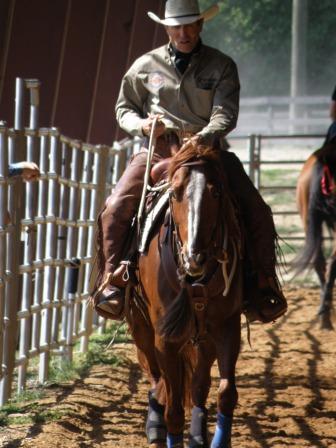 |
||||||||||||||||||||||||||||||||
|
||||||||||||||||||||||||||||||||
| Sydney's Story... | ||||||||||||||||||||||||||||||||
|
Gonna Skip Class ApHC
May 8, 2003 Sire: Upper Classman Dam: Pekoe Te Bar |
||||||||||||||||||||||||||||||||
|
Sydney's Story is in two parts.
The first is one of a vibrant and hot headed red head, full
of energy but completely controlled. Untapped
potential ,
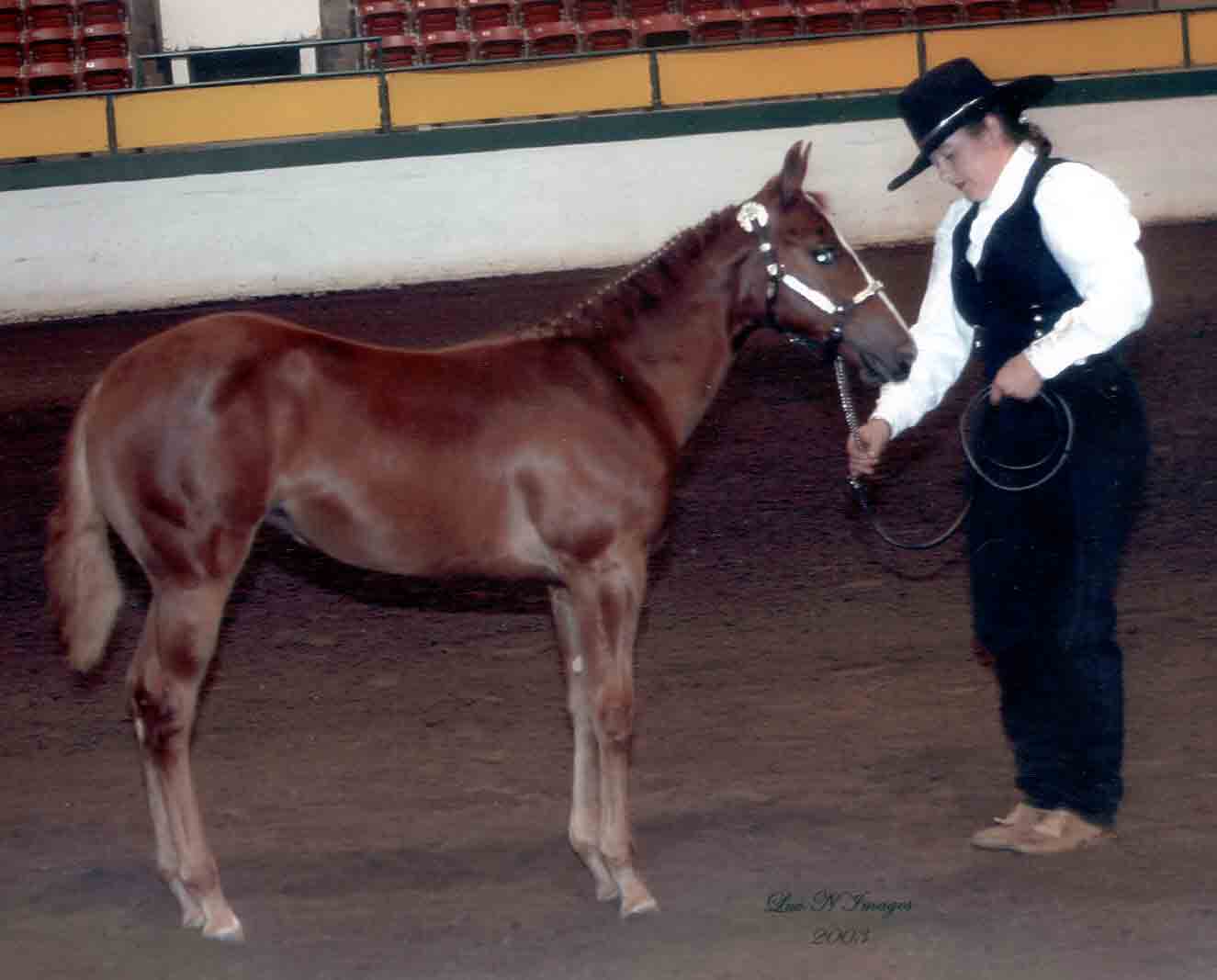 Syd was coming into her own and getting ready to take the
show ring by storm. Born small and late in the year,
the judges recognized her class and style. Sydney won the Jr. Weanling
Filly Futurity for NCAHA and placed fourth in the TAA Select Sire
Futurity for Weanling Fillies.
Syd was coming into her own and getting ready to take the
show ring by storm. Born small and late in the year,
the judges recognized her class and style. Sydney won the Jr. Weanling
Filly Futurity for NCAHA and placed fourth in the TAA Select Sire
Futurity for Weanling Fillies. Her sire Upper Classman, is a National and World Champion. Syd is Executive and Te N’ Te bred, a winning combination for a halter horse in addition to Skipper W and Three Bars that gives her the future for performance.
Syd had taken a fancy to reining and showed a
natural athletic ability and agility for the discipline. Even
though Sydney is a
small horse, she has a really big motor and a "go-go bring it on" attitude.
She always wanted to try and please. Jennifer and Syd participated in the April 2010 Craig Cameron clinic in NC. She impressed him enough to ask if she was for sale. Pictured is Syd with Craig Cameron. He really liked the way she moved. Training for the 2011 show season, Syd was getting ready to make her debut. March 2011 found Syd maturing her small body into a solid looking horse. This paddock picture is the last taken of Syd before her and our world completely changed.
|
||||||||||||||||||||||||||||||||
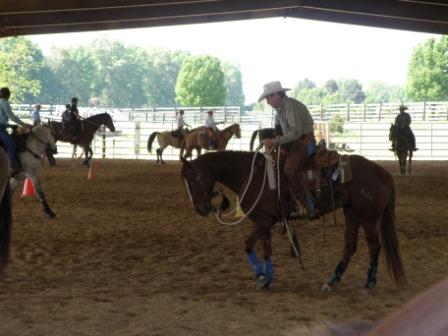 Craig Cameron riding Syd |
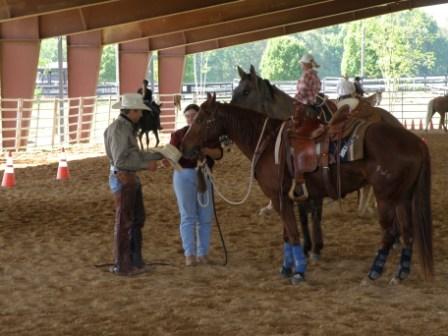 Jennifer with Craig |
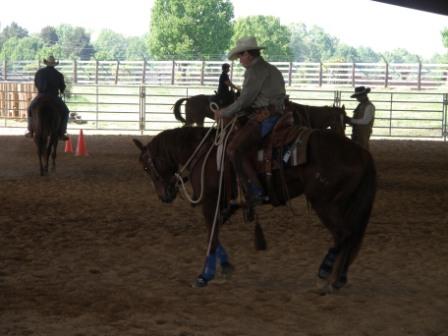 Craig Cameron riding Syd |
||||||||||||||||||||||||||||||
| Saturday April 30,
2011 was the same as any day. Bright, sunny and warm. We have
always fed four times daily, mainly to avoid digestive upsets.
Also to keep an eye on everyone since horses have such a unique
ability to go where no horse has gone before and do what cannot
be done. Lunch meal of beet pulp, was a normal feeding. Jennifer cut grass in the afternoon and fed the treat to the paddocked horses around 2:00 P.M. All was normal. Around 3:00 P.M. Jennifer went by Syd's paddock, and she found her standing on three legs, in a full blown sweat from pain, shaking hard enough to not balance easily. We both did a quick look and decided this was way more than a simple oops, called the vet and waited. With travel time about an hour away, we started putting frozen peas on her stifle, frozen ice packs wrapped in towels on her rump and what pain medication we had on hand to try to keep her somewhat comfortable. Basically, nothing worked. The damage she had done, was beyond what we could offer for relief. Trying to determine what she had done, we looked around her paddock. There were no broken boards, skid marks, or teeth marks on the horse next to her. We found dirt on half of her body from a roll, and could only guess that she rolled into the fence, put her legs through and when she tried to get up damaged herself, but we did not know how much damage there was. Dr. John Seale from Flat River Veterinary Hospital arrived and did the physical exam. He was afraid that she had torn a tendon or ligament as there was no responsive movement from the leg when rotated in the different directions. He also felt grinding and thought that bone was involved and the question became, was it the stifle or hip or more? He called our daughter Victoria Graham, DVM and together they discussed multiple possibilities of what we might be looking at. Sydney was drugged with multiple pain medications which allowed us to manipulate her into the barn, by pulling and pushing. Dr. Seale was not sure if she was salvageable and asked if euthanasia was an option. We indicated that we wanted to have her followed at the Vet School to see what we may be dealing with. The enormous amount of pain medications quickly metabolized creating additional pain with shaking. Knowing the seriousness of the condition, Victoria had already packed and started en route from Pulaski, VA. She wanted to access Sydney’s condition, start her on Acupuncture and medical treatment. She was given Electro Acupuncture immediately upon arrival which relaxed her enough to start eating hay. She was put on Bute for inflammation and Ulcergard to prevent ulcers. The Acupuncture was repeated on Sunday, Monday and Tuesday morning. An appointment for NCSU College of Veterinary Medicine was scheduled for Tuesday, May 3. Sydney would be traveling with Dobby (see Dobby's Page) to the vet school. Since he was a real trooper with an extensive stay already under his belt, they had lots to talk about on the trip. Upon arrival at the Vet School, we pulled directly into the receiving area to minimize the amount of walking that Sydney would have to do. She was able to get off the trailer by herself without assistance. Jennifer went with Syd for diagnostics and I went with Dobby for his nasal workup. Syd was first radiographed. The results showed, fracture of intercondylar eminence of the tibia at the attachment of the cranial cruciate ligament. She was then ultra-sounded and what was found was complete disruption of the fiber pattern of the medial collateral ligament, prolapse and mild irregularity of the surface of the medial meniscus of the right hind stifle and hyperechoic fragments with shadowing were noted in the medial femorotibial joint. The Orthopedic surgeon, Dr. Rich Redding and Victoria discussed their options and decided to go forward with surgery in an attempt to repair as much as possible and also to see exactly what damage had been done. 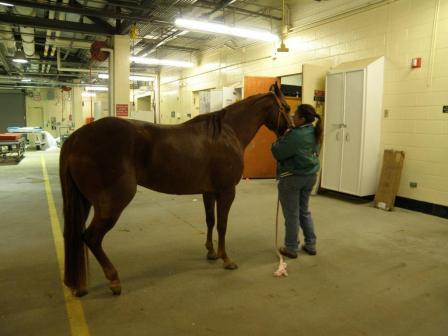 On Wednesday May 4th, arthroscopic surgery was performed to determine Syd's fate. Victoria was allowed to watch and photograph the procedure. Unfortunately, we have more knowledge of the vet world which is not a comfort at these times. You know how bad things really are or can be, wondering if you may still have a horse and will it be able to function later on down the road. Victoria would be in a position to determine how much surgery could be done or stop and just let her go. Surgery was completed, we still had a horse but faced the next hurdle. Syd had to come out of anesthesia without hurting herself, she only had three functional legs. The OR staff watched through the viewing panes, reported that she waited until she had her bearings before attempting to stand. Syd managed to stand in one fluid motion using her good hind leg. Pressing her head into the wall for balance, she stayed still and did not try to destroy herself. Jennifer was with her from then on until she was put into a recovery stall. Five large bony fragments were removed from her medial and lateral femorotibial joints. They came from medial intercondylar eminence of the tibia. Partial defect in the articular cartilage of the medial femoral condyle immediately adjacent to the fracture site. Borders of fracture sites were smoothed to aid in minimizing further cartilage damage. Extensive damage to cranial cruciate ligament and cranial ligament of the medial meniscus, both of which were debrided. Although intact the medial meniscus was completely separated from its attachment to the medial collateral ligament of the stifle. 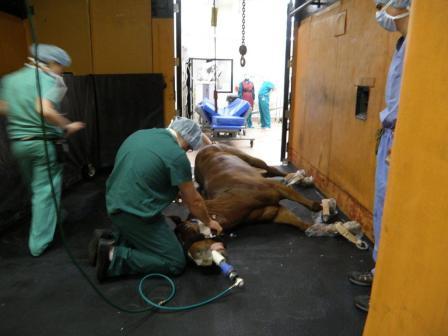 Our original program of Ulcergard to prevent the development of stomach ulcers was continued along with Bute for the post-surgical inflammation. Syd was kept quiet with sedation when activities at the hospital upset her. The pulses in her hooves had begun to rise, which resulted in icing her legs. Nanric Ultimates were applied to her hind hooves to help prevent laminitis. Her poor appetite and lethargic behavior was observed by the students in charge of her care. It was decided to release Syd on the 9th as she would recover better at home than in an upsetting environment. Victoria was consulted and she continued her Electro Acupuncture after surgery and again upon her release on the 9th. 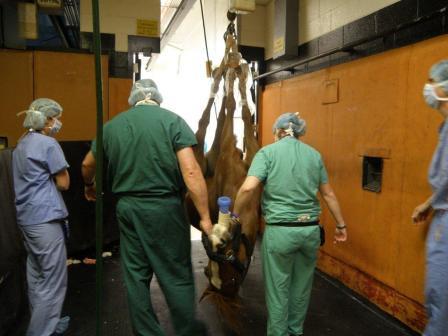 Stem cells were collected for processing the morning that Sydney was to go home. They would be injected in a couple of weeks. She had her Electro Acupuncture prior to loading on the trailer to help relax her for the ride home. She seemed happy to be in the trailer, in great spirits and was looking around with curiosity. 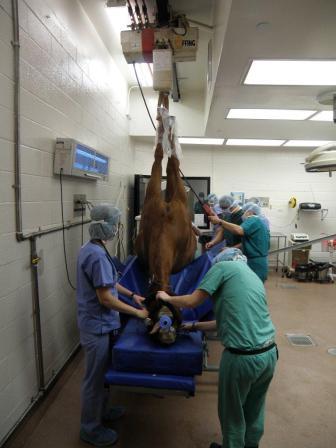 Dobby was scheduled for same day surgery on the 9th, so the pair rode home together. She watched as Dobby was loaded and knew she was going home. Syd ate her hay with a ravenous appetite. The change in routine, being in familiar surroundings gave her attitude and appetite a boost. When she arrived home she was happy to see her best buddy "Texas" in his stall next to her. Our question was answered when she lay down in her stall and slept for hours. She did not rest at the vet school with all the activity going on. Sleeping soundly, she looked relaxed and content. Now, how to get her up. Upon awakening, the little fighter managed all by herself with one hind leg and was standing three legged. She had figured it out. 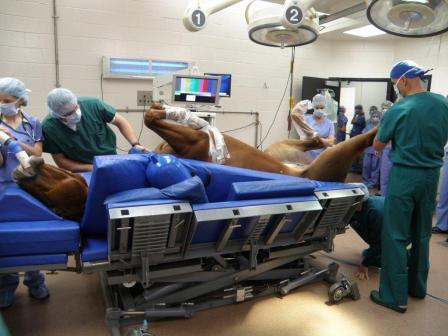 On the second day home, there was an extreme drop in feed consumption and behavior change, indicating that we had ulcers. The preventative dose of Ulcergard was raised to the therapeutic treatment dose level for the next four weeks and then reduced to the preventative dose for two weeks. The Vet School had no prior experience with a horse in Sydney's condition. The majority are put down immediately and never reach the school. Others are put down when it is determined how badly they are damaged and will not lead a useful life, so they never really reach surgery or do not come out of surgery. 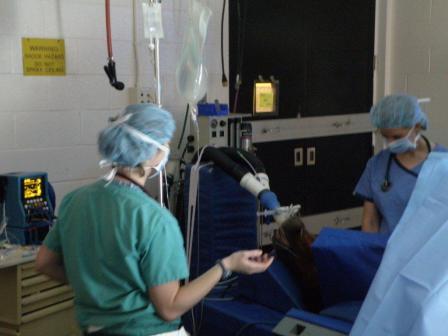 Syd will never be normal or ride again. The only reason we decided to continue was her attitude. She is a fighter. Easily handled, willing, but her will to live made it impossible to say good-bye to such a young creature that did not want to give up. Syd was on stall rest for the remainder of the summer. To keep her company through the most traumatic time, Texas was the main babysitter for the first two weeks. Then we alternated other horses in 12 hour shifts. 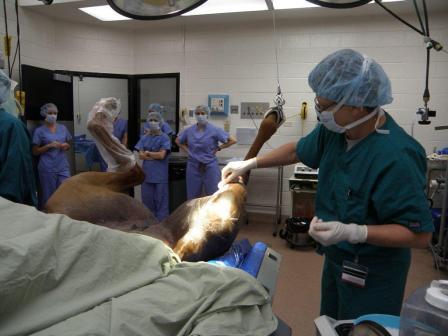 So our real physical work began. This is a commitment. No two ways about it. One person cannot do this alone. It takes everyone. We all had a part to play in this scene. Worry? Yes, we all sweated. We were facing colic, ulcers, laminitis, muscle spasms on the good leg from supporting her weight, and anything else you can think of. We kept her bedded deep, six inches of soft bedding. She was given Bute, Ulcergard and Electrolytes daily. Victoria started her on Chinese herbs to help prevent laminitis and aid in the healing of the tendons and ligaments. To maintain a monitoring schedule, Syd's meds were spread out for administering four times a day. A flow chart was designed to monitor the amount and size of piles, puddles, feed and water consumption, what time she was standing or lying down. Anyone going by the stall picked to keep it spotless and recorded the data. Temp, heart rate and digital pulses were checked twice daily. Several occasions indicated a rise in digital pulses, so we put ice boots on and kept replacement packs in the barn refrigerator. Stifle boots with ice packs were applied to keep the swelling and inflammation down. A portion of the summer was spent in keeping Syd in a chilled state. 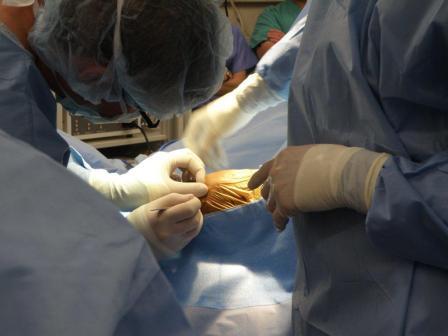 Syd's stall was the first stall in the barn. She was able to go outside for fresh air and to nibble on the grass that we left grow there for her. After a week she was able to take a slow amble a few yards away while her stall was being cleaned. Hoof care was virtually impossible at this time. Quick trims were done on the front feet when we caught her lying down. The Ultimates came off and required sedation to reapply to the weight bearing hind (the good leg). As they were on loan from the vet school, we decided to purchase our own. We also purchased Easyboot RX with additional pads for her front feet. Her slim little ankles made the boots difficult to keep on. During the brainstorming process, we put socks on her ankles and they made the difference in keeping her "sneakers" from coming off. Every couple of days her sneakers had to be removed to clean out the bedding and put on clean socks. 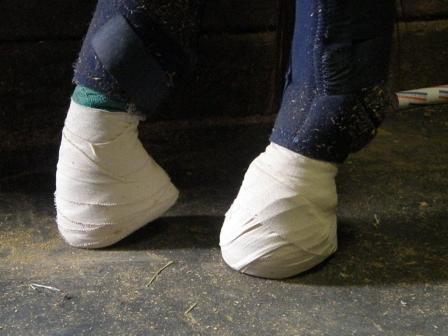 Syd was intelligent enough to know that if she would lie down on the other side, she couldn't get up. Since Syd was only able to lie down on one side, this created bedsores. She also developed sores on her left front elbows, knee and ankle and left hind ankle. We used either bag balm or corona ointment to keep the sores and scabs soft and aid in the healing process. This was an ongoing process that did not heal up and go away. The sores stayed for months. Periodically, the Ultimates came off as they were wrapped with elasticon and would collect moisture and bedding inside. As she moved around more, one of the boots gave way on the good hind leg. The amount of weight that was being put on the good foot was twisting and shifting the boot. We decided that removal of the boot was the best option. She could stand flat on the ground with no shifting or slipping of her foot. Syd was still not weight bearing on the injured leg. Trimming could still only be accomplished while she was lying down or if she was sedated. 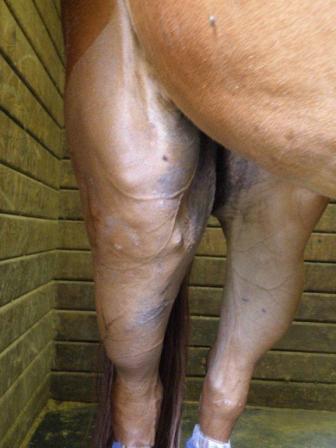 It
was June when Syd was able to tolerate T shoes. She was sedated
and the shoes were applied with Equipak pour pads with the hopes
to prevent laminitis in her fronts. This process was repeated
multiple times as it appears to have worked. It
was June when Syd was able to tolerate T shoes. She was sedated
and the shoes were applied with Equipak pour pads with the hopes
to prevent laminitis in her fronts. This process was repeated
multiple times as it appears to have worked.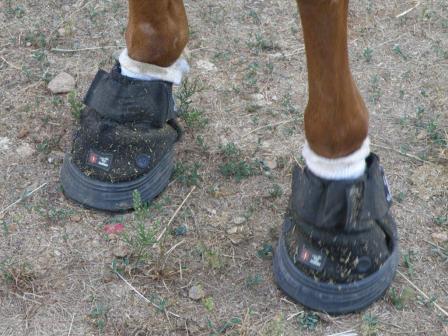 Chiropractic care was introduced in July by our farm chiropractor, Dr. Elizabeth Engel of Hillsborough, NC. It did not take long for Syd to figure out that she was getting relief from the pressure that she was having with the majority of her vertebrae out of alignment. Between being hung upside down on a rail track to the OR, and a contortionist in getting up and down, nothing was located where it was supposed to be. The first treatment gave her a world of relief. Through this time Syd continued to deteriorate in her body condition. Spending the majority of the summer in her stall, her muscles had atrophied. It was shocking and unbelievable as to how fast a horse can go downhill. A solid looking horse in the March picture found her now looking like something in a slaughterhouse yard. Her backbone was sticking up almost three inches, her hips protruded, ribs were visible and there was no rump. Her chest was gone and the neck sort of went into the body. We have no pictures of her at this stage. We had difficulty looking at her and if she died at this point, we wanted to remember her as she was prior to the accident. 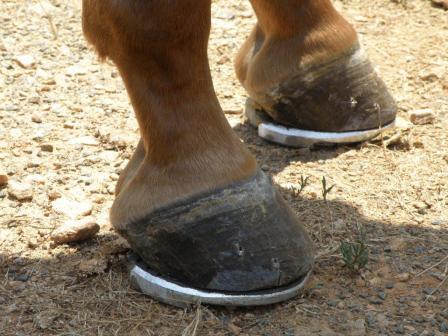 Now the therapy started, but we had no guidlines, no references and everyone was guessing. Every day was a challenge and we made it up as we went along. Syd had good days with progress and bad days with regression. Those days were terribly disappointing and heartbreaking. It was those days that you asked yourself if it was all for nothing, or if were you doing the right thing. Only God and Sydney knew so we kept plodding along. We were walking the fine line between rehabilitation combined with stall rest. An imbalance of either one would either be too much and set us back, or not enough and make no progress. What a choice. Short walks started outside the barn at a careful and slow pace. Syd was very weak and had very little control of her leg. It was a walk on tippy toe and drag, with an exaggerated hip rise and fall. We did this several times a day. She looked forward to going outside. Her treat was a break and some grass, then try again. She exhausted quickly and had labored breathing. As the days passed she gained more strength and the distance was enlarged for each trip even if it was only a couple of extra strides. After going in several circles we decided to move to the arena. She had to walk to and from the arena. Since I did most of her walking, I had no plans of carrying Syd back to the barn if she couldn't make it on her own. We only made one round to start with lots of stops for grass treats. As I started the walking program with Syd, I was able to learn how she reacted to the different footing in dry weather, or after a rain. If she wasn't paying attention and stumbled, or if the pace was not fast enough one way or too fast the other way. Eventually, one lap became two and two became three, and so on until we were making five to six laps each way. For a long time we only went one way as it was very difficult for her to travel with the bad leg to the inside of the circle and short stride. Syd would have good days and bad days. I adjusted the workout according to how she felt and the heat. We were advised to go both ways, but at first she couldn't handle it. As she became stronger and our laps increased, I incorporated figure 8's and serpentines with very wide turns so not to twist her leg. Eventually she was able to go the same amount of rounds each way of the arena and not tire. She always had a fast ground eating walk, and I quickly learned in the beginning that she needed to walk at her pace to keep her from stumbling. Restraining her at a slower pace actually shortened her stride on the front end, catching her bad leg as the leg came around in a swinging arc to follow through. Since she had no stabilizing tendons or ligaments she couldn't walk normal. Her leg was not able to follow through in a straight line. As the heat of the summer progressed, it took its toll on both of us. Night walks were shorter than mornings. Making long rounds in the morning was effectively boring for both of us. Entrusting the care of the horse to a hippy of the 60's does come with a bit of unusual methods. I sang old rock tunes to keep us both motivated and rocking along as we walked our way around. I'm sure Syd could chime in at any point. Every workout was followed with a great shower to cool down and wash the sweat off the skin to prevent more irritation. This is extremely important. The horse is undergoing enough stress with healing and therapy. Itching skin and rashes do not need to be added to the equation. Syd was now put on Smart Pak Resilience for joint support and tendon and ligament repair in addition to Smart TLC for anti-inflammation. 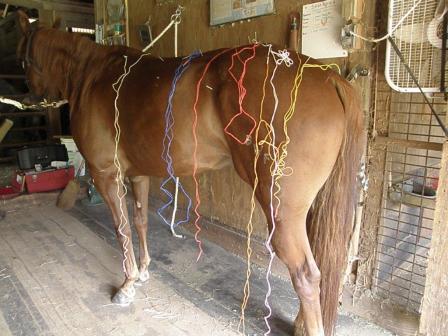 The beauty of all this work was the muscle tone was returning to her body. She was no longer looking like a piece of crowbait but showing promise of her past self. The picture of the September acupuncture shows her returning condition. Every six weeks her chiropractic visits showed more promise and Dr. Engel was pleased with her progress. She felt that Syd had progressed more than she had a right to with the extent of her injuries and the fact that it had not been that long since the accident. The most important thing that I can stress is that one person has to do the walking so they know the horses' movement and can pick up on the slightest change. You have to know when it is a good day or bad day and not push it. You have to be able to compare to the last trip or the other day or last week and know what is happening. A variety of handlers will not have this ability and the horse or progress or both will suffer. August arrived with more heat, drought and dust. We modified Syd's existing paddock down to a 16 x 16 size. Fine screenings were brought in to give her stable footing and cushioning. We noticed that during Syd's walks she was making an attempt to drop her right hind heel, however, she couldn't get it down enough to reach the ground. After hours of research on the net, books, and brainstorming, the idea was to shoe the right hind and wedge the heel up. A shoeing plan was put into effect. 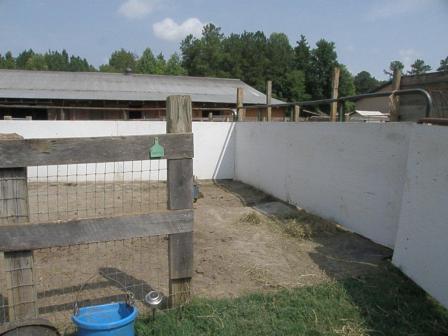 September
was the first attempt at shoeing. Cutting
a hard plastic pad into riser strips, stacking them at her heel to
create a wedge to actually wedge the heel until ground contact
was made, seemed to work. For added support we used an Equipak
pour pad. The initial start was four riser strips which were attached
to the shoe via bolts screwed into the shoe. September
was the first attempt at shoeing. Cutting
a hard plastic pad into riser strips, stacking them at her heel to
create a wedge to actually wedge the heel until ground contact
was made, seemed to work. For added support we used an Equipak
pour pad. The initial start was four riser strips which were attached
to the shoe via bolts screwed into the shoe. On October 1, three weeks later one riser strip was removed. Syd seemed to handle the change with no problems. On October 28 she seemed ready to handle a change, one more riser strip was removed and she was down to two. Shoeing was difficult for Syd as it had become evident that her left hind was not able to be shod. Keeping her even to provide additional support was not going to be possible as she could not bear weight on the injured right hind leg. We had to come up with a plan to support her. At this time Syd was hit with another bout of ulcers. She received the required treatment of Gastrogard followed by Ulcergard. The decision to remove the Smart TLC from her diet was made in the case the Devils Claw was upsetting her stomach. She was started on Chinese herbs for Happy Stomach. Once again research started on the net, this time for slings. We located a sling company just around the corner from Vicky. We were on the right 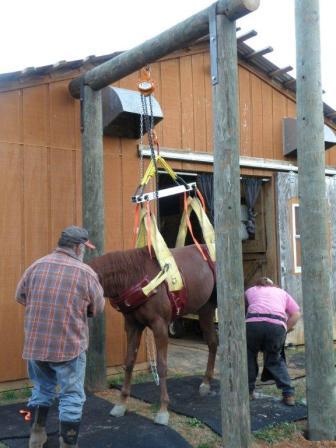 track, the universe was looking out for us. In order to use a
sling, a support had to be built, sturdy enough to hold a moving
horse should it panic. The support was built from electric
poles, deeply set into the ground. The sling was able to be
rented to see if it would fit our purpose prior to purchase.
Thank you to Dr. Kathleen. Please see Becker Slings from Hast
PSC Large Animal Rescue Equipment
http://rescue.hastpsc.com
track, the universe was looking out for us. In order to use a
sling, a support had to be built, sturdy enough to hold a moving
horse should it panic. The support was built from electric
poles, deeply set into the ground. The sling was able to be
rented to see if it would fit our purpose prior to purchase.
Thank you to Dr. Kathleen. Please see Becker Slings from Hast
PSC Large Animal Rescue Equipment
http://rescue.hastpsc.comThe first venture was on November 4. With lots of trial and error in the effort to line everything up, Syd was shod all around in the sling. To support the left hind a shoe was applied with a little lateral extension. A Sliding Plate fit full was used, with an Equipak pour pad for support. Even with sedation, Syd was apprehensive about falling. Vicky held her injured leg and physically locked her stifle into place as it was not able to lock on its own. On occasion, Jennifer was tossed around like a rag doll, but the left hind was shod, with lots of bruises for all participants. In November we doubled the size of her turnout. She was now close to having 2/3 of her original paddock for exercise. She enjoyed the larger size, which she used to move about more often throughout the day. We noticed that her muscles were toning with the additional exercise. The next shoeing occurred at Christmas. With pre-shoeing medication it went well with fewer bruises for all. We continued to learn how much tension Syd liked on the sling. This will be different for any horse, so be prepared for trial and error. She also indicated how she liked her left hind leg held. Where she felt comfortable and secure while balancing on the injured right hind. 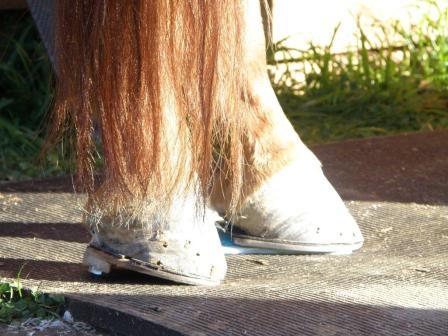 It
was decided to try her bare on the front as she had soft, sandy
footing in her turnout. This shoeing also changed her from two
riser strips down to one on her right hind shoe. It
was decided to try her bare on the front as she had soft, sandy
footing in her turnout. This shoeing also changed her from two
riser strips down to one on her right hind shoe.February's shoeing was awesome. The pre-shoeing medication was slightly altered. By now we had a better idea of what Syd likes in regards to the tension of the sling and positioning. She was left bare in the front. Her right hind had a slight change by applying an aluminum three degree wedge with Equipak. The last riser strip was removed. The Slider Plate with Equipak was once again used on the left hind. A long overdue dental was performed while in the sling. The unstable leg had prevented the dental from being performed previously. The sling rental period was now over so Bouncing Wonders Veterinary Service is now the proud owner of a Becker Sling. 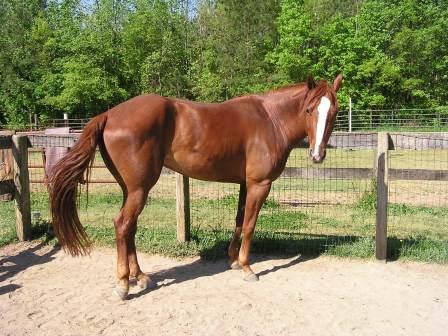 It is now March 2012. Ten months have passed since the accident. It has been a long haul, but the progress that Mother Nature has made is astounding. Without her, this would not have been possible. We can only assist. Syd’s paddock has now been restored to its original size of 20 x32, giving her lots of room to move about. She manages little lopes, a few awkward bucks and we just hold our breath. She is alive, happy and that’s what counts. April shoeing came and went well with the same technique as the February routine. At this time she appears to be doing well. We passed the April 30 anniversary of the accident. At first glance one would not be aware of Sydney’s handicap. When she steps out it is apparent that something is wrong with her hind leg. June was a normal month. No changes were made to the shoeing routine or sedatives. A T shoe with Equipak was used again. Syd had a spell where she tweaked her leg. The injury came as no surprise as the running and bucking had accelerated in her paddock due to feeling frisky. She is having problems with her stifle locking and if makes it more difficult for her to move about. As we progress and change routines, this journal will be continued. We will also update everyone on how well Sydney is doing. Sydney’s story is remarkable. She is definitely, “The Little Horse That Could.” |
||||||||||||||||||||||||||||||||
|
For information on medical care for this injury contact Dr.
Victoria Graham at
www.bouncingwondersfarm.com For information on shoeing for this injury contact Jennifer Graham at jlg@boundarywatersfarm.com |
||||||||||||||||||||||||||||||||
|
||||||||||||||||||||||||||||||||
|
|
||||||||||||||||||||||||||||||||
| TOP OF PAGE | ||||||||||||||||||||||||||||||||
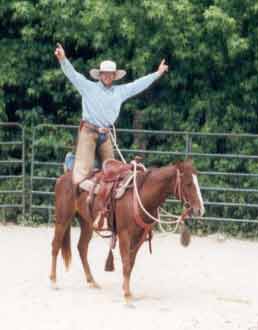 Sydney had been started under saddle by Wyoming
Natural Horsemanship Clinician, Justin Morgan. She was flagged,
ridden over obstacles, rode on trails,
crossed water, worked the ball,
clipped, loaded and worked both leads all by the tenth ride.
Sydney had been started under saddle by Wyoming
Natural Horsemanship Clinician, Justin Morgan. She was flagged,
ridden over obstacles, rode on trails,
crossed water, worked the ball,
clipped, loaded and worked both leads all by the tenth ride.